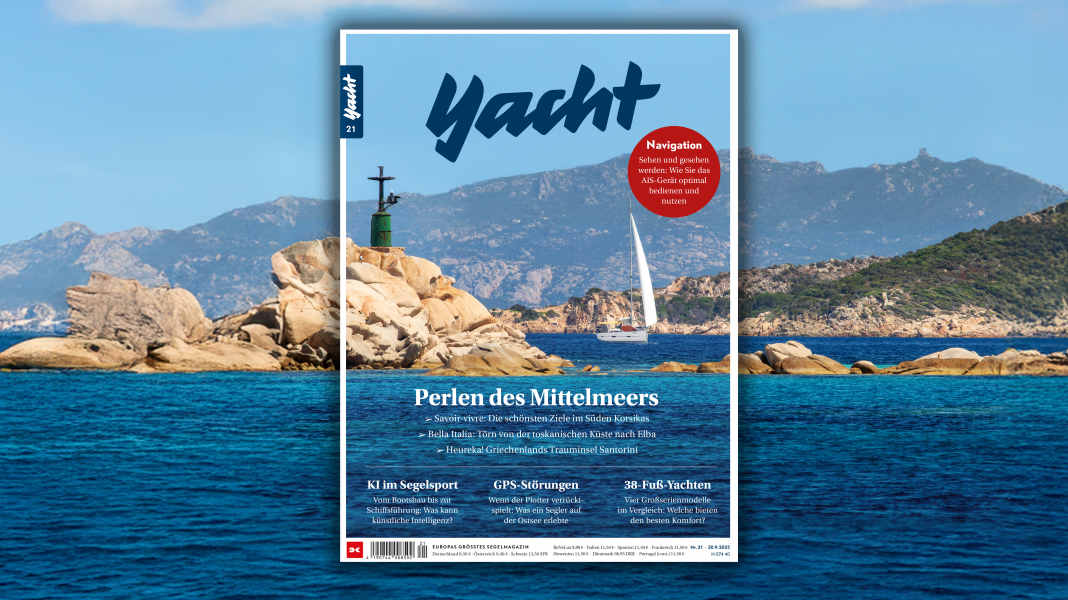
The extensive Mediterranean special focuses on three attractive sailing areas. The magazine is also dedicated to current technical developments such as the influence of artificial intelligence on sailing and examines in a large comparison test which eleven-metre large series cruising yacht offers the best price-performance ratio.
Safety-related topics are not neglected either: a field report on disrupted GPS signals in the Baltic Sea emphasises how important traditional navigation skills still are. The magazine is supplemented by reports on special events such as the harbour festival in Mommark and a look behind the scenes of the Sailing Forum, which has been an important platform for exchange in the sailing community for 20 years.
Fantastic anchorages between Corsica and Sardinia
The Mediterranean Special begins with a detailed presentation of the most beautiful anchorages in the Strait of Bonifacio, which runs between Corsica and Sardinia. The region is one of the most popular sailing areas in the Mediterranean, but can be quite crowded in the high season. YACHT shows you when and where you can still enjoy fantastic sailing trips without being surrounded by crowds. The bays and anchorages presented not only offer protection from wind and waves, but also impressive landscapes and crystal-clear water. The article provides valuable tips on the best time to visit and the local specialities that sailors should take into account when planning their trip.
Relaxed exploration of Santorini
Another highlight of the Mediterranean special is the report on the Aegean island of Santorini. The volcanic island, known for its white houses with blue domes, is one of the most popular tourist destinations in the Mediterranean. However, the article shows how the popular island can also be explored in a relaxed way while sailing. Far away from the streams of tourists that arrive daily on cruise ships, Santorini also offers numerous attractive places for sailors. YACHT provides practical tips on anchorages, marinas and the best times to visit in order to experience the authentic Santorini without being surrounded by crowds.
Cruise to Elba steeped in history
The third part of the Mediterranean special takes readers from Viareggio to the Tuscan archipelago and in particular to the island of Elba. The trip combines the sailing experience with a journey to places steeped in history, above all, of course, the sites on Elba associated with Napoleon Bonaparte. The report describes the route along the Tuscan coast and provides insights into the cultural and historical features of the region. In addition to practical navigation tips, the article also contains recommendations for shore excursions and places of interest that are well worth a visit.
The new YACHT 21/2025 is now available at newsagents and newsagents, and will soon be available in the Delius Klasing App ready for download. Or you can simply order them directly here...
to the annual subscription...
to order a single issue...
Artificial intelligence in sailing
Another highlight of the current issue of YACHT is the comprehensive AI report. The article examines which sectors are already successfully using the new technology and in which areas manual labour is still indispensable. Artificial intelligence is increasingly finding its way into sailing - from weather forecasting and route planning to the optimisation of sail shapes and boat design. The report sheds light on current developments and provides an outlook on future potential applications. It becomes clear that while AI can simplify and improve many processes, human experience and intuition are still required in some areas of sailing.
Four yachts in comparison
In the second part of the large comparison test of eleven-metre yachts, YACHT takes a closer look at the Bavaria C38, Hanse 360, Oceanis 37.1 and Sun Odyssey 380. After analysing the sailing characteristics in the first part, the current test focuses on space, living comfort and pricing. The four yachts represent different concepts in the popular 11-metre class and appeal to different target groups. The detailed comparison helps prospective buyers to make a decision and shows which boat is best suited to which requirements. Both the strengths and weaknesses of the individual models are openly discussed.
Navigation problems in the Baltic Sea
A particularly relevant article for safety at sea deals with GPS interference in the Baltic Sea. As a result of the war in Ukraine, GPS signals have been disrupted in parts of the Baltic Sea, which can lead to considerable navigation problems. A YACHT reader reports on his experiences with this phenomenon and shows how important it is to master traditional navigation methods. The article reminds us that even in the age of electronic navigation, the art of dead reckoning - i.e. determining a position based on course, speed and time - should not be forgotten. For sailors travelling in the affected region, the report offers valuable tips on how to deal with the disturbances.
Further topics at a glance
YACHT 21 also offers a wide range of other interesting topics:
- Dramatic mast breakage on the classic "Tuiga"
- Latest news: Financial aid for traditional ships, effects of global warming, insolvency of Niro-Petersen, murder trial against Berlin sailor, twelve-boat regatta off Marstrand
- Travelling topics: Sailing ferry to England, online check-in in Lübeck, bridge disruptions in Husum
- New boats: US cruiser Catalina 48 and offshore trimaran Neel 48
- Commentary by Steffi von Wolff on the surveillance mania of some boat owners
- Report on model boat building and sailing as a challenging hobby
- Insight into the harbour festival in Mommark with a quirky pile stool competition
- 20 years of the Sailing Forum: Interview with Stefan Beeger about moderating mostly factual, but sometimes heated online debates
- AIS practice: Correct setting and sensible use for navigation
- Equipment innovations: Spare parts from the 3D printer, sailing goggles with camera, smartwatch with satellite and LTE connection
- Presentation of practical storage containers and storage aids for the pantry
- Portrait of the Chiemseeplätte as a special boat with a long tradition
